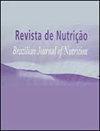Availability of foods according to the degree of processing in families with young elderly and oldest-old (POF 2017-2018)
IF 0.5
4区 医学
Q4 NUTRITION & DIETETICS
Revista De Nutricao-brazilian Journal of Nutrition
Pub Date : 2022-01-01
DOI:10.1590/1678-9865202235e210251
引用次数: 0
Abstract
ABSTRACT Objective To compare the availability of healthy and unhealthy foods in families with and without elderly and oldest-old people. Methods This is an observational, cross-sectional study with secondary data from the Household Budget Survey, conducted by the Brazilian Institute of Geography and Statistics between 2017 and 2018. Families were characterized based on the oldest member: Control (without elderly and oldest-old) or with elderly and oldest-old. The sociodemographic characteristics of the families and the foods purchased by the families were obtained, according to the Nova classification (in natura, processed and ultra-processed foods, in addition to culinary ingredients). Results Families with elderly and oldest-old people had greater availability of fresh foods and fewer ultra-processed foods. In contrast, young families showed greater acquisition of all ultra-processed food items. Conclusion The unfavorable nutritional transition process with fewer in natura foods seemed to be less evident in families with higher age groups. It is concluded that the presence of the elderly and oldest-old in the family could be related to a better quality of the family diet, with a greater presence of fresh foods and a lower acquisition of ultra-processed foods.根据加工程度,有年轻老人和老人的家庭中食物的可用性(POF 2017-2018)
【摘要】目的比较有老人家庭、无老人家庭和老年家庭中健康食品和不健康食品的可得性。这是一项观察性横断面研究,使用了巴西地理与统计研究所在2017年至2018年期间进行的家庭预算调查的二手数据。家庭的特征是基于最年长的成员:对照组(没有老人和老人)或有老人和老人。根据Nova分类(天然食品、加工食品和超加工食品,以及烹饪配料),获得了家庭的社会人口特征和家庭购买的食品。结果有老年人和老年人的家庭新鲜食品的可得性较高,超加工食品较少。相比之下,年轻家庭对所有超加工食品的购买都更多。结论在年龄越大的家庭中,天然食物越少对营养转变的不利影响越不明显。结论是,家庭中老年人和最年长的老人的存在可能与家庭饮食质量更好有关,新鲜食品的存在更多,超加工食品的获取更少。
本文章由计算机程序翻译,如有差异,请以英文原文为准。
求助全文
约1分钟内获得全文
求助全文
来源期刊
CiteScore
1.20
自引率
12.50%
发文量
24
审稿时长
6-12 weeks
期刊介绍:
Revista de Nutrição is former Revista de Nutrição da Puccamp, founded in 1988. It is a bimonthly publication every four months and it is of responsibility of the Centro de Ciências da Vida, da Pontifícia Universidade Católica de Campinas . It publishes articles that contribute to the study of Nutrition in its many sub-areas and interfaces; and is open to contributions of the national and international scientific communities.

 求助内容:
求助内容: 应助结果提醒方式:
应助结果提醒方式:


